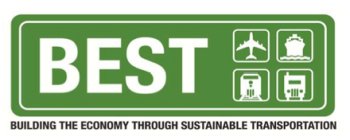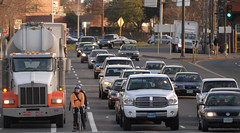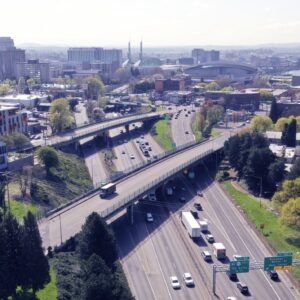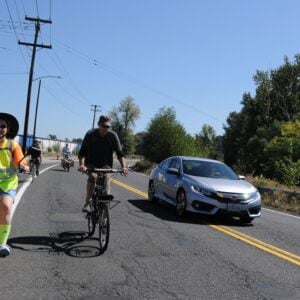Next week, Metro’s 17-member Joint Policy Advisory Committee on Transportation (JPACT) will vote on a policy direction that will guide them in handing out $20-24 million in federal transportation funds. With scarce transportation dollars at stake these days, freight and active transportation advocates are dueling to get their projects a larger piece of the pie.
This funding pot, known as “Regional Flexible Funds” have been extremely important for non-motorized transportation projects in recent years. Last year, Metro allocated a record amount of this money — around $10 million — to biking and walking projects while freight projects didn’t receive a dime. According to Gerik Kransky of the Bicycle Transportation Alliance, in the last two funding cycles, active transportation and complete streets projects have received an average of $19.9 million from this process.
“It’s unfortunate that these groups don’t seem to understand the value of active transportation in our community enough to support funding it at a higher level.”
— Gerik Kransky, BTA
Lake McTighe, project manager for Metro’s Active Transportation Partnership, says this money is “one of the main sources for bike and ped projects.” But, she adds, they are not specifically designated for any one type of project. “Each cycle, JPACT can look at the process of how those funds are allocated and they can change it.”
Leaders from public health, land use, environment, and biking and walking non-profit organizations wrote a letter to JPACT on June 9th urging them to maintain funding of active transportation projects current levels.
Last week, the BTA sent out an action alert to members because a coalition of freight and business interests have countered their efforts and hope to convince Metro to set aside a larger percentage of the money for freight projects. On June 8th, a letter signed by 15 people — including representatives from the Portland Business Alliance and Port of Portland as well as companies like Schnitzer Steel, Weyerhaeuser, Columbia Sportswear, and Fred Meyer — called on Metro to “strategically build the foundation for our green economy and recognize that freight mobility is an important part of that goal.”
Here’s another excerpt from the letter:
“Historical funding levels for freight projects… (approximately 1.8% of total funds per cycle) are not sufficient to address our region’s pressing need to create jobs and increase economic activity.”
One of the signatories of that letter, Port of Portland Executive Director Bill Wyatt, proposed a motion at JPACT’s June 17th meeting calling for a 75-25 split of the flexible funds. Wyatt wants Metro to direct 75% of available funds to “Green Economy/Freight Initiatives” (about $18 million) and 25% of the funds to “Active Transportation/Complete Streets” (about $6 million).

— but with an additional economic advantage.
The BTA’s Kransky says Metro is giving the proposal some serious consideration. Why? “The likely reason is political pressure.” On the BTA blog, he wrote, “It’s unfortunate that these groups don’t seem to understand the value of active transportation in our community enough to support funding it at a higher level.”
“JPACT started saying we’ll start applying a lot more to bike/ped… now it’s ballooned to a much larger percentage of funds… It’s sort of like going, ‘whoa what happened here?’.. Maybe we got slightly off track.”
— Corky Collier, Chair Portland Freight Committee
Kransky’s argument is that freight gets funding through a variety of other — and much larger — funding pots and that these regional flexible funds are a vital funding source for biking and walking projects, which currently get only 2% of the region’s total spending on transportation projects. “Regional Flexible Funds represent a small fraction of total regional transportation spending,” he writes, “but they are nearly one quarter of all regional bike and pedestrian spending.”
Corky Collier, Chair of the City of Portland’s Freight Committee, says if there are big pots of money for freight projects somewhere else, he’d love to find them. In response, he says, “Please point me to those pots… I just don’t know what they are. It’s easy to assume that the other group has all sorts of money.”
Collier says it’s the right time for JPACT to focus their funding allocation policy because the pendulum has swung too far in favor of biking and walking projects in recent years. The process in the past was “a little bit mushier” he says and it lacked the analysis to back up the increase in active transportation spending. “JPACT started saying we’ll start applying a lot more to bike/ped… now it’s ballooned to a much larger percentage of funds… It’s sort of like going, ‘whoa what happened here?’.. Maybe we got slightly off track.”
Collier says that since there are more active transportation projects in the works these days, “It behooves us to start thinking a little more carefully which the best projects are.” In a letter to the JPACT committee, Collier wrote,
“In the past, our investments in active transportation were not based on market studies, but rather in providing incremental connections to and from parks, transit, etc. As the region funds active transportation projects that cover more distance, we should increase the use of market studies and consider the practical limitations of active transportation.”
Also in his letter, Collier pointed out that only 4% of the trips in our region are made by foot or bike.
Even if the freight coalition doesn’t get the 75/25 split, Kransky says another proposal being floated by Metro Councilor Rex Burkholder is a 60/40 active transportation/freight split. That would also be a reduction and Kransky says “60/40 would be a cut and the BTA won’t support that.”
JPACT will meet again on July 8th where they’ll make a final decision on the parameters and policy direction of this funding allocation.






Thanks for reading.
BikePortland has served this community with independent community journalism since 2005. We rely on subscriptions from readers like you to survive. Your financial support is vital in keeping this valuable resource alive and well.
Please subscribe today to strengthen and expand our work.
Collier pointed out that only 4% of the trips in our region are made by foot or bike.
It’s pretty difficult to make a trip by foot or bike if the infrastructure isn’t there to begin with, don’t you think?
Business leaders need to stop looking at active transportation as a just another way for people to get around but a way to reduce their freight costs.
More people cycling and walking reduces total traffic load on any road. This effect increases with density so that as population and commercial density increases so too does the mode share that choose to walk and cycle.
Fewer private autos on the road reduces travel time for delivery.
Fewer private autos on the road allows heavy vehicles to maintain a more average speed and thus reduce fuel costs.
Fewer private autos on the road ultimately reduces the amount of what we truck drivers call “amateur drivers” or “@#$!^& four wheelers!”. Any reduction in accident prone drivers is will reduce overall exposure of freight drivers to potential vehicular crashes.
So, active transportation will save money for freight interests because a reduction in labor, fuel and insurance costs.
All this dependent upon a walking and cycling transportation that is not hostile or dangerous to its users.
Our current system is barely better than an after thought.
Dear Kelsey Newell & Metro JPACT:
When you meet on July 8, please consider the fact that active transportation is currently not funded equitably compared to other modes of transportation, such as large trucks and freight vehicles. In recent surveys, we can see that up to 18% of Portlanders identify the bicycle as a primary or secondary form of transportation, and another 30% ride transit regularly. These constituencies represent the demand for increased funding for active transportation projects, particularly the availability of off-street, separated pathways.
I am sure all JPACT members are familiar with the positive benefits of investing in active transportation, so I will only summarize. Besides creating jobs; reducing our healthcare costs; keeping money in our local economy; and reducing local emissions and congestion; building a world-class walking, biking, and mass transit network is the only way we will achieve our region’s long-term sustainability goals.
Active transportation advocates understand that not everyone is going to pedal a bicycle or catch a bus to get around, but we are confident that everyone will enjoy the positive benefits of creating a sustainable transportation network. Please find a list of benefits we all receive from investing in bicycle infrastructure, attached. Thank you for your time.
—
I just sent this in, feel free to use/modify if it helps you get a letter in. I just received the following in response:
“Thank you for your e-mail. I will include your e-mail in tomorrow’s JPACT mailing to members, alternates and interested parties. In addition, hard copies of your e-mail will be provided at the meeting.”
WRITE IN NOW! It takes 10 minutes, and it’s worth your time.
So we are talking about businesses who transport a lot of crap we don’t need (certainly, some we do but A LOT we don’t) who are lobbying for public money to greenwash our continued dependence on fossil fuels.
Sorry, pay your own freakin way and leave tax dollars for human scale infrastructure that actually strives for livability and for the region’s larger pollution reduction goals.
q’Tzal is right.
An answer to Corky Collier. Here you will find nearly 17.25 million dollars of Connect Oregon III money for the Port of Portland alone, a leading voice asking for RFF funding for freight. To say nothing of the lion’s share of the nearly 100 million for other freight projects. The same list contains approximately nothing for bike and ped.
These freight investments are important, to be sure. But they are simply barking up the wrong tree for money. De-funding regional bike and ped projects in the Portland Metro region is a bad idea, and that is what they are asking for.
Also, to clarify, Councilor Burkholder has been a strong voice for maintaining funding for active transportation and complete streets projects with regional flexible funds.
The current discussion among JPACT members to split funding 60/40 is actually 60% for active transportation and 40% for freight. Rex did not introduce a resolution as described above.
The BTA views the 60/40 split as a cut to vital complete streets projects, and we oppose it.
Gerik. I regret the error and have corrected the story. Thanks. — Jonathan
Gerik
The current funding, as I’ve read it, for active transportation is not guaranteed and has been sporadic.
I do not agree with “B.E.S.T.’s” position that they need to take money from active transportation, HOWEVER, they do seem to be proposing a minimal but stable funding source. They might try to use this as a “pro-bike” selling point.
Please refute.
Damn… to bad that walking and biking projects are not “Green” like freight is…
During the last MTIP cycle, Regional Flexible Funds were awarded as the funding source for the next step in making the North Portland Willamette Greenway a reality.
At the urging of npGREENWAY and our partners, many of you spoke up and made that possible. We are very thankful for that!
Now, we need everyone to speak up again to preserve the funding source for these types of projects!
From a cost projection standpoint is it a blessing and a curse that active transportation infrastructure requires very little in the way of maintenance funding?
It is good, of course, that bike and pedestrian infrastructure gets very little wear. Compared to heavy vehicle wear bikes and pedestrians are non-existent. This is what points to active transportation infrastructure as a superior community investment.
On the down side, without the continual need for funding for upkeep the public, and thus legislators, get the impression they can just throw us a bone and that will be it. Sporadic funding and continual fights to re-justify our existence.
Please understand that most in the freight community, including myself, support adequate funding of active transportation projects. If you run into someone that complains about bicyclists, send them to me…I’ll be glad to educate them. The mode that is eating the lion’s share of funding and providing the least economic or environmental benefit is the single occupancy vehicle. This is where much of our angst should be focused.
To the extent that we have to choose between active transport and freight, I advocate a continual improvement of our project analysis tools. Not every bike project should be at the top of the list and not every freight project deserves our highest praise. The best way to demonstrate the value of active transportation projects is to improve the way we rank them alongside other modes. To do otherwise eventually undermines our goal of showing how valuable they truly are.
Corky
Uh what about B-line? They are bike and Freight all in one. How come they aren’t included in that nifty little bumper sticker up there with all the other “best” freight haulers? It looks to me that not only does B-line benefit from active transit dollars but they are also economically beneficial freight hauler within the city.
Convince rail companies nationwide to upgrade rail yards, container, and transshipment stations so that the switching and routing of freight cars occurs in a way that resembles the speed and efficiency of a Cisco Systems enterprise router; not the slow labor intensive early 19th century way it occurs now.
OMG. Sorry you don’t move multi-ton rail cars like data in cyberspace. Wow are people really that out of touch?
I think my earlier link to the Connect Oregon III document is broken.
Try this: http://www.oregon.gov/ODOT/COMM/CO/docs/FRC_Priorities_6-14-10.pdf
And to Corky, whom I like personally and value our working relationship. Project evaluation is great, but that happens later in this process, during the summer stakeholder engagement and project selection. Right now we are setting funding targets and we find ourselves in an unfortunate situation of a false choice between bikes and freight. You are right, both communities share goals and we share strategies to achieve those goals. Reducing Vehicle Miles Travelled is where we should focus our investments.
Using “market studies” to evaluate transportation investments is only one small piece of the puzzle. Our projects should deliver clear measurable benefit in terms of:
1. Making the most of our existing system. We can extend the working life of our streets by calming traffic, striping bike lanes, and adding sharrows to them. This allows more people to use our roads and keeps them in better condition for longer.
Just look at the increasing number of people using the Hawthorne Bridge. Many of those people, since the infrastructure exists, choose to ride a bike. As a result, the current span can accommodate the increased use as demand goes up. If we had not invested in the separated multi-use path those users would be in cars, maxing out the bridge’s capacity, and we would be talking about a multi-million dollar replacement span.
Investments that make biking and walking safer and easier save taxpayers’ money.
2. Promote personal health. Policy statements and health impact assessments from the CDC to our local health agencies make clear the benefit of physical activity. Adding 30 minutes of exercise to our daily commute promotes personal health. It reduces our health care costs, reduces obesity and our likelihood of heart disease, and reduces incidence of asthma due to cleaner air.
Investments that make biking and walking safer and easier promote personal health.
3. Reduce global warming pollution from cars and trucks. Nearly 40% of all carbon emissions in Oregon come from the transportation sector. We will reduce that number, as state policy requires, in three ways. Reducing the carbon content of fuels, increasing the efficiency of vehicles, and decreasing the amount people need to drive. We should be building a 21st century transportation system that gives people more choices in how they get around.
Investments that make biking and walking safer and easier are clear environmental priorities.
4. Promote financial security. We are in the middle of a nasty recession. People are losing their jobs and struggling to make ends meet. Housing and transportation combined consume the majority of our household income. Cars are expensive, both to buy and maintain. Living near a neighborhood greenway that is safe and comfortable for riding a bike, with good access to transit facilities, keeps money in people’s pockets. Research has shown a “Green Dividend” in Portland, money that stays in our community due to the fact that we drive less than the national average.
Investments that make biking and walking safer and easier keep money in our pockets and promote a stronger local economy.
So yes, let’s improve our project analysis tools and let’s make sure we rank transportation investments based on the benefits they provide for people. I look forward to that conversation.
Red Five #14
Well Duh!
Go watch the rail yard switching in NW Portland or any other US rail depot.
Sure they are moving around 90 ton cargo packets and there is inertia to deal with but the simple fact of the matter is that rail transport is slow compared to OTR trucking and much of this slow down can be accounted for in the seemingly necessary stop in every urban area.
Energy wasted on decelerating.
Energy wasted on accelerating.
Money and time wasted on moving individual cars one at a time manually.
Certainly what I’m suggesting is FAR beyond the scope of any local authority but Rail transport has the potential to completely supplant all but intracity trucking if only it would pull its day to day practices out of the 18th century.
The US rail system has shown that it is capable of innovation, they were the first to implement barcodes on any applicable scale, but there is so much room for improvement it is aggravating to see it fall behind a little more every day.
Wait… there`s no ring road?.. I`m sorry but the photo looks scary.
FYI. Another $42 million was just spent to plan the CRC.
What good are pennies for active transportation from metro when this $4 billion single passenger vehicle project in Portland is being marketed as “national significance”?
http://blog.oregonlive.com/commuting/2010/07/sen_murray_gets_42_million_for.html